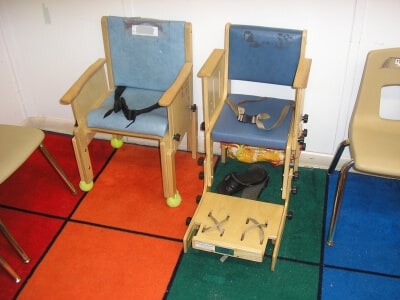In previous articles, I told you that restraint and seclusion are permitted in schools. I explained what a restraint is, when it is permitted, and what information the school must report to you. I talked about reducing the use of restraints by focusing on positive behavior interventions. In this article, I will explain more about the use of seclusion.
Seclusion means confining a student alone in an enclosed space which the student is prevented from leaving. This might be accomplished by locking the door to the space, or having a staff member hold the door shut. It might mean that a staff member is blocking the doorway. Or it might mean that the student is physically unable to leave the space (e.g. a student who cannot propel her own wheelchair) or does not understand that she can leave the space.
Schools sometimes use the term “time-out” instead of seclusion. Time-out is very different from seclusion. Time-out just means the student is separated from his peers. The student could be in a different part of the classroom or in the hallway. And the law does not regulate the use of time-out in North Carolina.
You also might hear the term “isolation.” Isolation means that the student is confined in an enclosed space, but she is not prevented from leaving that space. The key question to ask is whether your student is prevented from leaving a space. If so, the school is using seclusion.
Schools are permitted to use seclusion where it is reasonably necessary to prevent injury to the student or others. In addition, they may seclude a student if seclusion is written in the student’s Individualized Education Program (IEP), Behavior Intervention Plan (BIP), or 504 plan. Staff must release the student as soon as the behavior that led to seclusion has ended, or according to the directions in the student’s IEP. Seclusion cannot be used solely for discipline or punishment.
The law outlines the requirements for any space used for seclusion. The space must have appropriate lighting and temperature control. It cannot contain any objects that might harm the student (sharp or metal objects, ropes, toilets, chemicals, etc.). The space must be approved by the school system to be used for seclusion. Staff must be able to see and hear the student at all times while in the space. The door may have a lock, but only where the lock engages by a person holding it in place. If the door has an electric lock, it must open automatically when the fire alarm goes off.
In circumstances where staff believe seclusion is necessary to prevent injury, they may use any available space. The issue of whether that space is appropriate for seclusion is a common area of conflict between parents or guardians and school staff. Disability Rights NC has received reports complaining about the use of bathrooms, storage closets, and even large cardboard boxes for seclusion. If the space does not meet the requirements in the law, it cannot be used for seclusion.
The law only requires staff to notify you that they used seclusion on your student if the use was not permitted by the law, if it lasted longer than ten minutes, or if it lasts longer than the time written in the student’s IEP. The school must verbally notify you about the incident no later than the end of the following work day, and must give you a written incident report within 30 days. The incident report must describe the date, time, nature, and duration of the seclusion; what led to the seclusion; other interventions staff tried before using seclusion; any injuries to your student; and who to contact with questions.
However, it is best practice for the school to notify you every time seclusion is used. This is particularly important because staff may not recognize that they secluded the student when it was not permitted and therefore are required to report it. You should advocate for your student’s IEP or BIP to include a requirement that staff document and notify you about any use of seclusion. The documentation should include all the information listed above.



